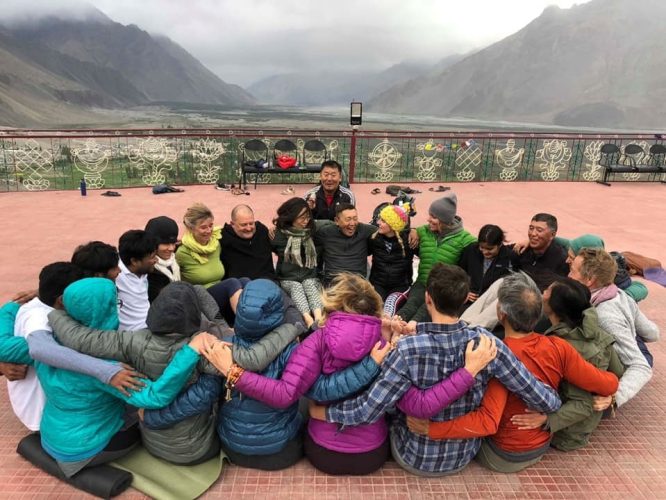People are lonely. This seems to be a socialization byproduct that we’ve been hearing about since the beginning of time (even before “Eleanor Rigby” was released by John Lennon and Paul McCartney in 1966). People are communal and tribal by nature; we need each other, but it’s often difficult to create community in today’s world and culture that values independence, self-reliance, and nuclear families. Loneliness can feel even heavier this month, which places such an emphasis on love, specifically romantic partnerships. One anecdote I’ve found to the epidemic of isolation is satsang.
What Is A Satsang?
In addition to the name of my favorite band, satsang is a Sanskrit word that refers to a like-minded, spiritually-minded community dedicated to seeking truth. I decided to dig a little deeper, surveying scholarly yoga-instructor colleagues who offered the following definitions:
- From Gideon Enz: “A community that intentionally gathers together for (inquiry into) what is good and true.”
- Prajna Vieira describes it as, “keeping the company of the wise and virtuous.”
- An online acquaintance from India says sat means “good,” and sanga means “companionship,” making its literal translation “good companionship.”
Other definitions I came across include:
- a collective gathering of people to exchange good ideas and thoughts
- right association
- like-minded people who engage in spiritual dialogue
- a spiritual discourse given by a knower of truth
- friendship
- shared intent
- spiritual spark
- agreed-upon rules
What Does A Satsang Do?
I grew up in a smaller, suburban town in Michigan. While there was no particular dedication to “seeking truth,” there was a certain set of beliefs, typically held in small, midwestern communities. For example, my community valued Friday-night football, boating, family time, and being neighborly. Compared with larger, more urban areas, people in smaller towns are more intimately related to each other’s experiences, services, and needs.
Although it’s not as essential as in the past, many still look to traditional religious institutions to find spiritual community. However, shared religious beliefs are not required of satsang members. College is another form of community. After my own experience at a university, I made my home in a very small mountain town with a population of 3,100. (When I moved there in 2001, I became the 3,101st resident!) With essentially the year-round population of a high school, this high-rockies town also had a shared belief system and priorities, such as a love of nature and the outdoors, skiing, and mountain biking as necessary life skills, supporting local ecology and community. This town had so much heart; neighbors would always help each other, and the local doctor was always readily available for anything from a medical emergency to playing the trumpet. Recently, while visiting as a former resident (somewhere between a local and a tourist), I noticed that sweet spot of satsang that is, in my humble experience, a little more challenging to find in bustling cities. It seems that in our fast-paced, transient lifestyles, community is one thing that has taken a significant tier down in our collective priorities.
In addition to the benefits a community can offer, here are some reasons we might come together in satsang:
- sharing dialogue, communicating, and connecting
- spiritual reflection and discussion; dharma talks
- singing and chanting
- eating and being merry
- meditation
- building something (for instance, a wellness center or yoga studio)
- seva, or selfless service
Why Satsang Is So Important
We are social creatures by nature. Dating back to primitive times, if you were isolated from the group, you could not survive. As Brene Brown puts it, “we’re hard-wired for connection.” And yet, the downfall is that, because of this, we might stay in groups that don’t serve us or our well-being. As the old adage goes, “misery loves company.” We are highly influenced by those around us, so it’s important to surround ourselves with people that lift us up and can remind us of our inherent capacity for good. Satsang is a way to support others and feel supported, while avoiding negativity. A satsang can help you stay on your path (whether spiritual growth, or personal development), as the momentum of the group can help you stay aligned with your shared values. Meanwhile, these shared experiences will increase our capacity for compassion and, ultimately, happiness. Cultivating community can even boost longevity. (If you’re not familiar with Bhutan, take a look at how this country measures success.) As a result of happier populations, additional social impacts might include:
- psychological well-being
- social vitality and connection
- education
- arts and culture
- physical health
- time or work-life balance
- environment and nature
- government
- material well-being
How To Find Your Satsang
Over time, in one way or another, we’ll inevitably face life changes – be it relocation, family growth, or value shifts. During such transitions, it’s easy to feel isolated. However, it’s during those times that we need to lean into community, specifically one that is aligned with where we are going (or growing). Rooted in love and truth, satsang takes the benefits of a community to a deeper level. But, how do we find our satsang? How can we cultivate a sense of community in our lives? Here are some simple steps to help you get started:
- Reach out. Unless you’re a host of others, satsang most likely doesn’t happen in your living room. However, if you live in a rural place or have less access to people who share your interests, online forums can bridge the gap between real-life community and feeling all alone.
- Seek it out. Go to events that personally lift you up. For me, this is kirtans, potlucks, meditations, and yoga classes. One can find satsang in art and dance classes, community events, and even at your local coffee shop!
- Help others. Seva will help others and connect you with like-minded folks who share your values.














